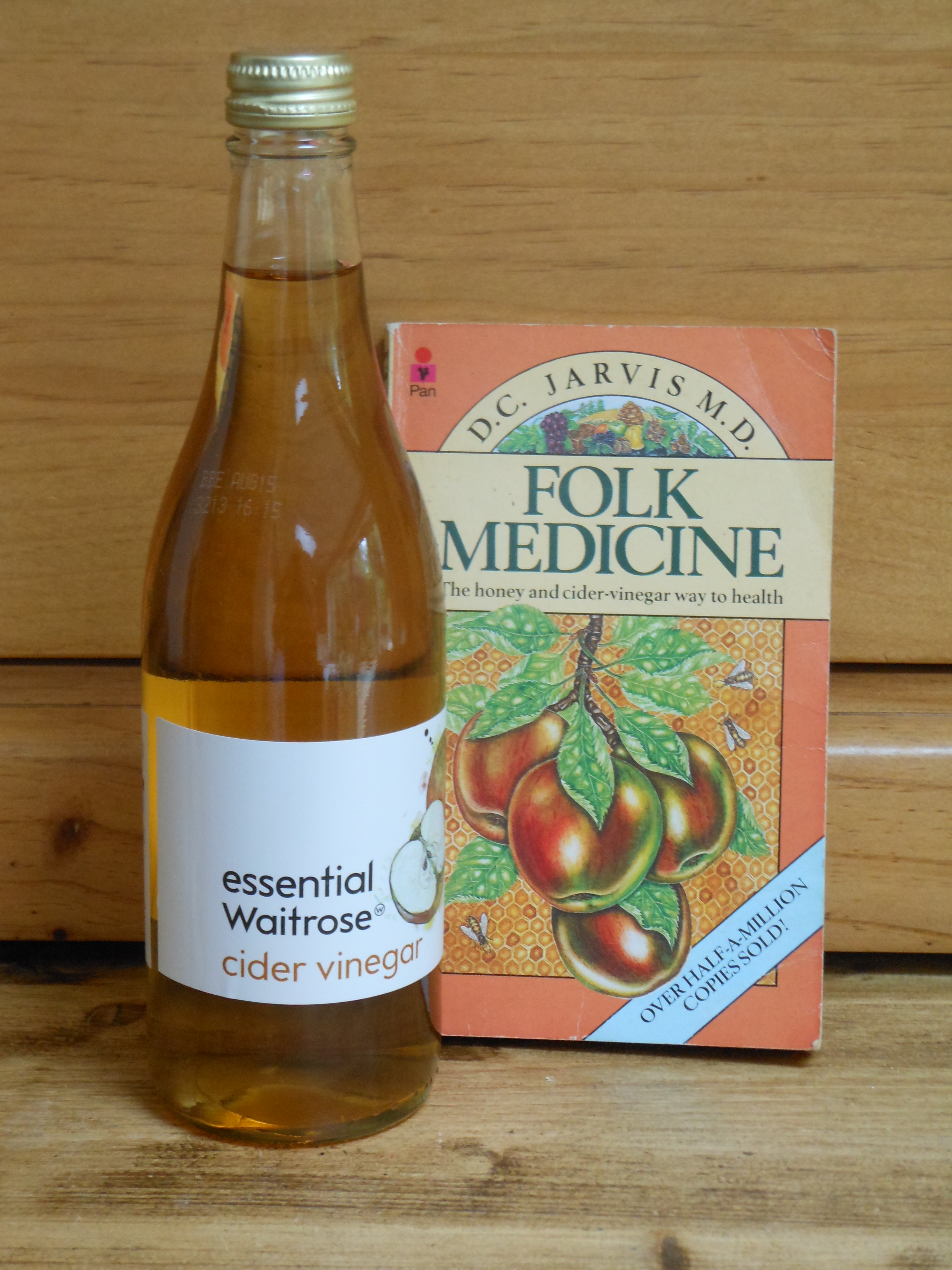 |
OCTOBER 2013
APPLE CIDER VINEGAR
One of my favourite books is FOLK MEDICINE: The honey and cider-vinegar way to health published by Pan Books. Written by D. C Jarvis MD, a doctor from Vermont, USA, it’s a fascinating fount of useful hints on how to take care of your health using these simple ingredients. Based on careful observation of the longevity of the farming families in his district who endured exceptionally harsh winters he noted how they successfully self-treated their ailments. Dr Jarvis then subjected their recipes to his own chemical analyses to discover the science behind their methods.
Apple Cider Vinegar has many useful properties. It’s antispasmodic, anti-bacterial, anti-fungal and helps to maintain a good metabolic balance thus aiding digestion. It is also famous as a treatment for arthritis as it helps efficient use of calcium in the body and encourages healthy growth of bones and teeth. Uses:
- For bronchitis and catarrh. Warm a small glassful of cider vinegar and water in a saucepan until it boils. Transfer to a bowl and inhale the steam with head under a towel and over the bowl until respiration is easier.
- As a slimming aid. Sip a couple of teaspoons dissolved in warm water just prior to meals to reduce appetite and assist the digestion.
- For insomnia. Drink a warm glass of apple cider vinegar with honey half an hour before going to bed to encourage restful sleep.
- Drink warm with a little honey to treat urinary tract infections.
- Thrush. Drink daily to treat thrush, and apply a little vinegar with water to the exterior of the vagina to ease itching; it can also be added to bath water.
- Eczema, athletes’ foot and ringworm. Apply to the skin in the same way as for thrush.
- Wasp stings. Apply neat apple vinegar to reduce swelling and discomfort.
- Osteoarthritis: For lameness and painful joints: The following case from Dr Jarvis’s book describes a farmer who suffered from severe osteoarthritis. He dissolved 10 teaspoonfuls of apple cider vinegar into a glass of water and drank it with each meal each day. (30 teaspoonfuls a day seems excessive to me, but I merely quote from the book). On Day One his arthritis was 20% better and by Day Four he was 50% better. By the end of the month on this regime he was 75% better. His pain had reduced as his lameness disappeared and by the end of the month he had no pain left in the joints and in the back of his head and neck.
Dr Jarvis went on to describe an experiment he had done dissolving calcium-rich eggshells in apple cider vinegar which demonstrated the efficacy of the vinegar as a remedy for dissolving bone overgrowth. As someone who has a genetic predisposition towards osteoarthritis I shall try this out to see if it works on me!
|
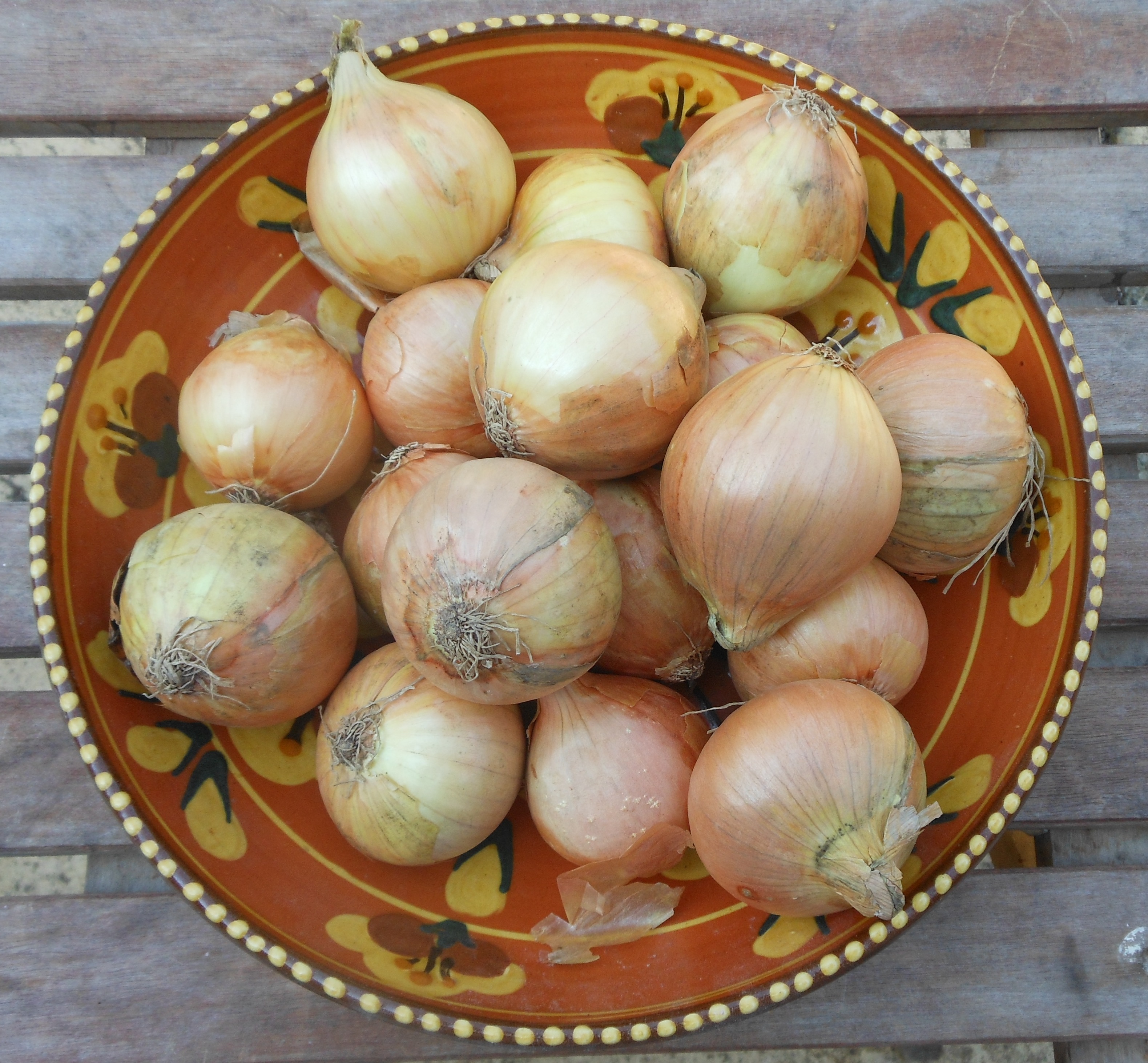 |
SEPTEMBER 2013
ONIONS
This month I harvest my onions and very useful they are too for cooking and medicinal purposes. I heard on my radio today that in India this year there is a shortage of onions due to droughts and floods and people, especially poorer families are devastated as they use onions daily in their recipes to keep well. ‘Now onions are the same price as cheese, what shall we cook?’ they complained.
Onions are often used for treating colds which you can sometimes get at the end of September if the weather suddenly turns. Onions are expectorant and strengthen the lungs; they are warming and increase blood circulation; diuretic and cause the body to ‘weep’, releasing toxins. (Think of the effect on your eyes when chopping them!). They have antibiotic qualities and so are able to draw out infection. They also help to reduce cholesterol after a fatty meal and cleanse the intestines, helping to maintain the balance of bacteria; therefore they are thought to be useful in helping to prevent some cancers of the digestive tract.
Altogether, a most useful vegetable; it’s not surprising they are used so often in curries.
Practical applications:
- Apply fresh onion to an abscessed tooth or boil to draw out infection
- Mix raw onion juice with honey to relieve the symptoms of a cold
- Taken daily they are helpful with nervous debility
- Onion poultices are helpful laid on the chest to relieve bronchitis
- Poultices of roasted onion can relieve the pain of earache but don’t poke it into the ear canal, just lay the poultice over the external part of the ear that aches.
- Raw, crushed onion encourages healing of bruises and sprains and to relieve the pain of arthritic inflammation. Lay the onion over the affected area but do not use on broken skin.
Allium Cepa (common red onion) is also used as a popular homeopathic remedy to treat colds where profuse runny discharges pour out of the nose in colds. They are therefore also helpful in treating hay fever. Use Allium Cepa 30c for colds where the natal catarrh burns but simultaneous discharges from the eyes are bland. Use the homeopathic remedy Euphrasia 30c where the nasal catarrah doesn’t burn but the discharge from the eyes does.
|
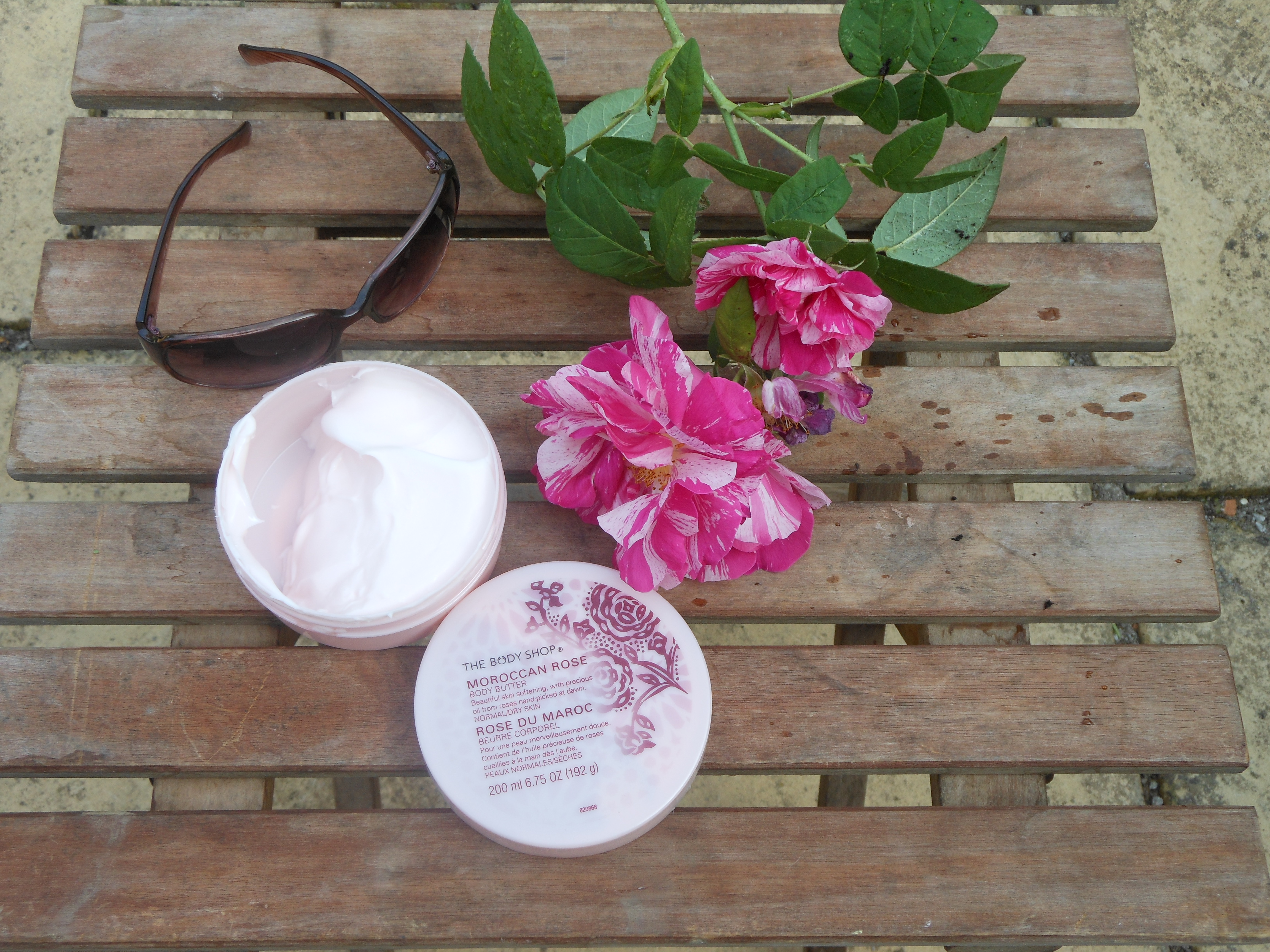 |
AUGUST 2013 REMEDY
MOROCCAN ROSE BODY BUTTER
Having been on holiday to Sicily where I had a wonderful time swimming in the sun every day my skin needed rejuvenating even though I’d been careful to use a high-factor sun-block spray. I found Moroccan Rose Body Butter by the Body Shop, made from roses hand-picked at dawn an excellent product, soothing, nourishing and quickly absorbed. I used it every evening and by the morning my skin was smooth and soft. The evocative scent of roses lingers for quite a while.
|
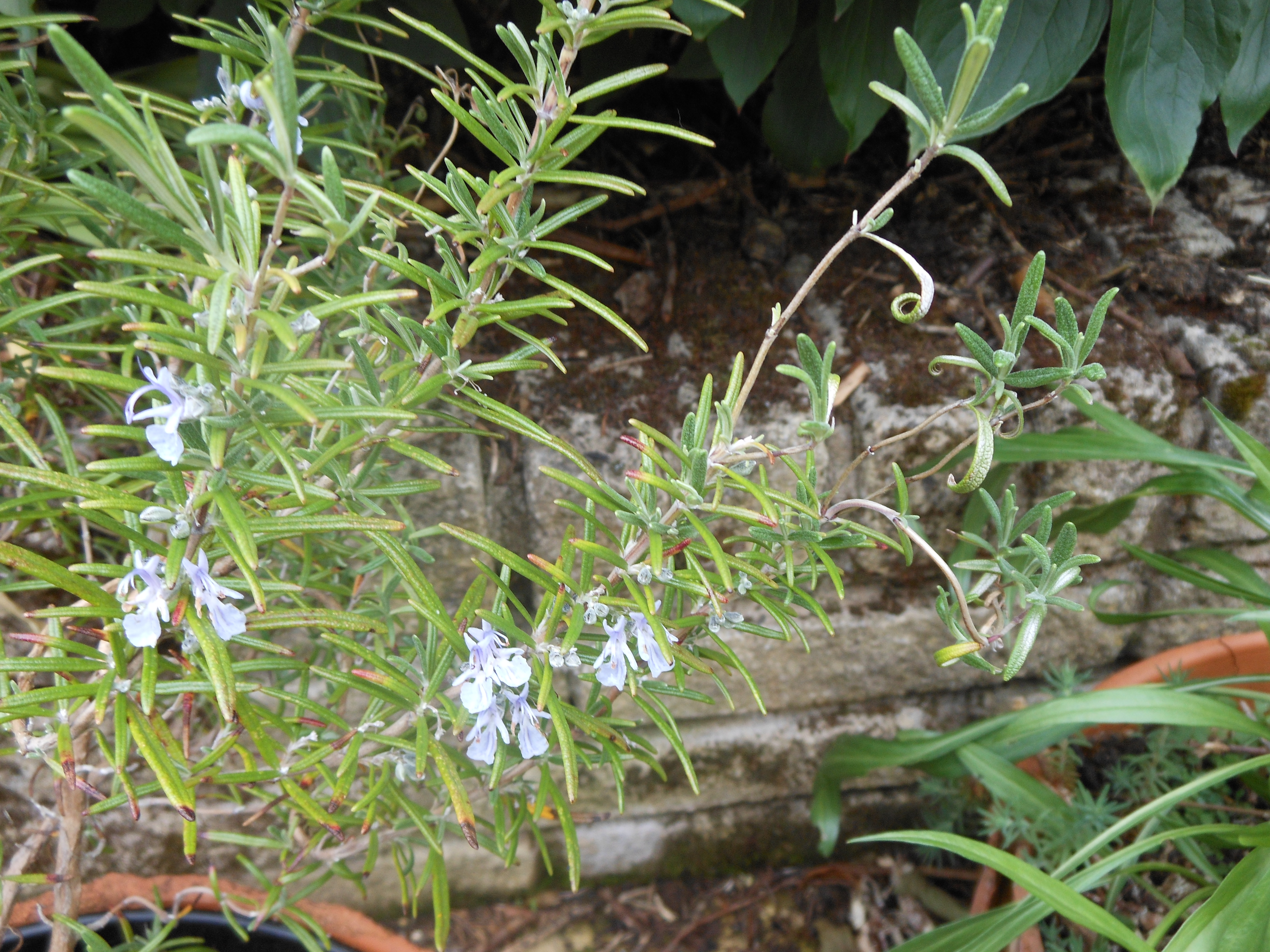 |
JULY 2013
ROSEMARY FOR REMEMBERENCE
Memory problems are increasingly common with an ageing population, but people of all ages can experience intermittent forgetfulness and lack of focus following times of mental stress, alcoholic indulgence, accidents to the head or illness. Students may become fearful of forgetting all they know before exams. Fortunately there are a number of remedies that can help.
Poor nutrition can be one cause of memory loss and a diet rich in Vitamin B and proteins is necessary for the brain to function efficiently. An amino acid supplement containing all 22 acids may be useful, and eggs and sunflower oil which contain lecithin can help. Ginseng powder and gotu kola can also revive a sluggish memory. These can be obtained from most good health food shops.
For people with difficulty remembering names the homeopathic remedy Calcarea Carbonica can be useful as an acute aid, and the homeopathic remedy Phosphoric Acid is used for what used to be called ‘brain fag’ for students worn out with swotting for exams. However, it’s best to seek professional help if these problems persist. Most GP surgeries offer a Memory Clinic service where your memory or lack of it can be properly assessed. For all these recommended remedies, do make sure you follow the instructions on the bottle or packet.
However, this month’s herbal remedy which you can easily make at home features Rosemary (Rosmarius Officinalis). To quote from Nicholas Culpeper in his 17th century text book The Complete Herbal: ‘It helps a weak memory and quickens the senses.’ It enhances the functioning of the brain by improving the circulation.
Modern herbalists recommend the dried herb for infusions in the proportions of one teaspoonful of leaves to a cup of boiling water. Make the amount you need in a teapot and leave to infuse for 15 minutes. You can sip a cup of this tea up to three times a day, but pregnant women should avoid large doses.
Rosemary tea is also helpful with depression, headaches caused by gastric troubles, poor digestion and for sore throats used as a gargle. Rinsing the hair in rosemary tea makes it very shiny. You can add 15 drops of the essential oil to a bath to ease muscular tension improve circulation and lift your spirits. Rosemary is a wonderfully pungent herb and is brilliant with lamb dishes or on roast potatoes.
|
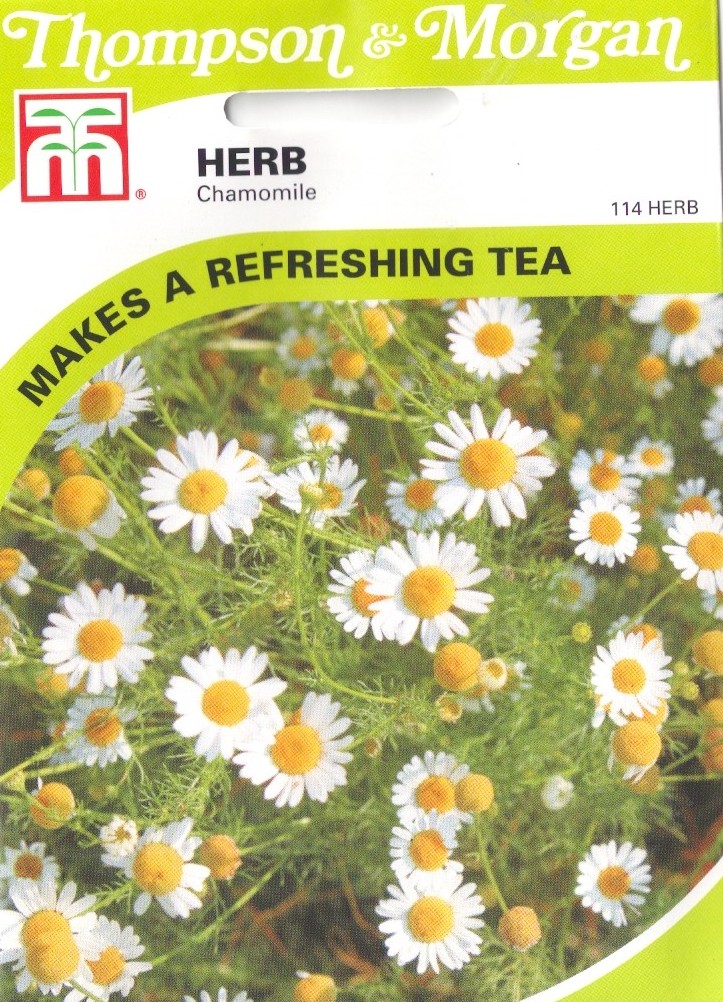 |
JUNE 13
CHAMOMILE TEA
At this time of year many of us, fed up with the dreadful weather we’ve been enduring, are planning holiday flights to exciting destinations abroad. Unfortunately, as the departure date grows nearer some people discover a growing sense of anxiety as they dread the idea of flying. Remedies that can help to soothe are much in demand, and one of these I recommend and grow is Chamomile tea.
This charming aromatic plant, chamomilla recutita, has anti-inflammatory, antiseptic and digestive properties. Its daisy-like flowers makes a calming tea when made to the proportion of two teaspoons of freshly-cut flowers to 1 pint (500ml) boiling water in a tea pot. Keep the lid on while the liquid is infusing so the steam does not escape. Sips of the tea can be taken internally by adults freely, or a whole cup of tea can be taken twice a day. For over-excitable children, reduce the dose by infusing one teaspoon of the flowers to a pint of water and dilute this further to 2 or 3 teaspoons dissolved into some pure fruit juice.
It is useful remedy when sipped for treating headaches, insomnia, heartburn, and can also be helpful used externally to bathe and soothe itchy skin.
Occasionally some people develop an allergic rash when taking this remedy but this will disappear on stopping use of this herb.
|
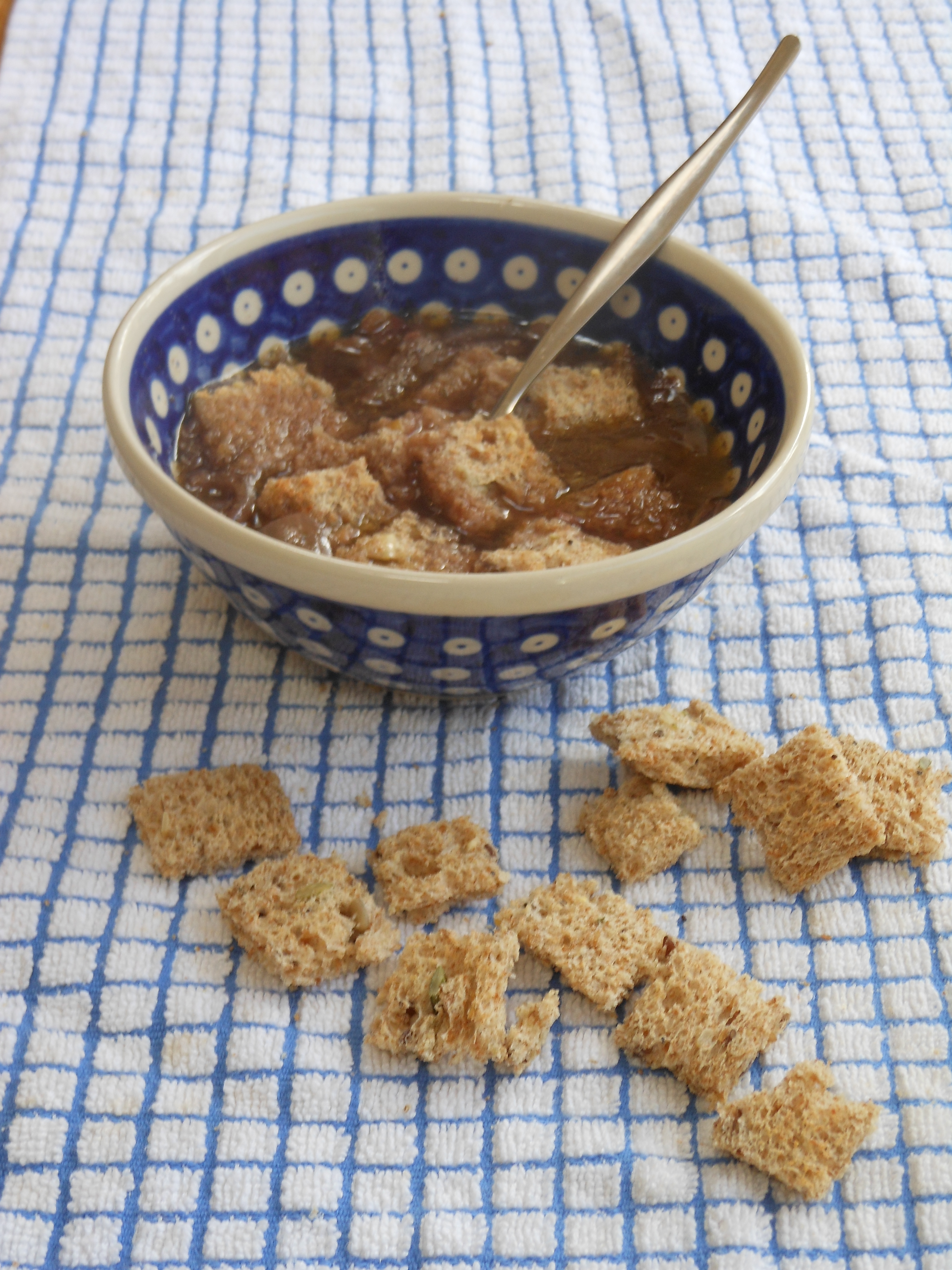
|
MAY 2013
ROAD TO RECOVERY REVIVING ONION BROTH
Despite all my efforts to keep well during this very late cold spring we both went down with chest infections. As soon as I felt well enough I made this classic recipe which is brilliant for people needing nourishment while ill but not wanting to eat much. It’s full of vitamin C and very digestible for recovering invalids. As my appetite gradually returned I made some lentil soup for the following days; see my recipe for this under May’s Recipe section.
¾ lb (350g) thinly sliced onion
2 cloves chopped garlic
1 oz (25g) butter
1 oz (olive oil)
½ teaspoon granulated sugar
¼ pint (150 ml) red wine
1 pint (600 ml; 20 fluid oz) vegetable stock
Salt and freshly ground black pepper
Toasted croutons
- Heat butter and oil gently together in a large saucepan
- Add prepared onions, garlic and sugar and simmer for about 30 minutes, stirring occasionally until the bottom of the pan is covered in a brown caramelised film.
- Add the stock and wine bring to the boil then simmer for an hour until the broth is dark brown.
- Serve in soup bowls scattered with croutons.
|
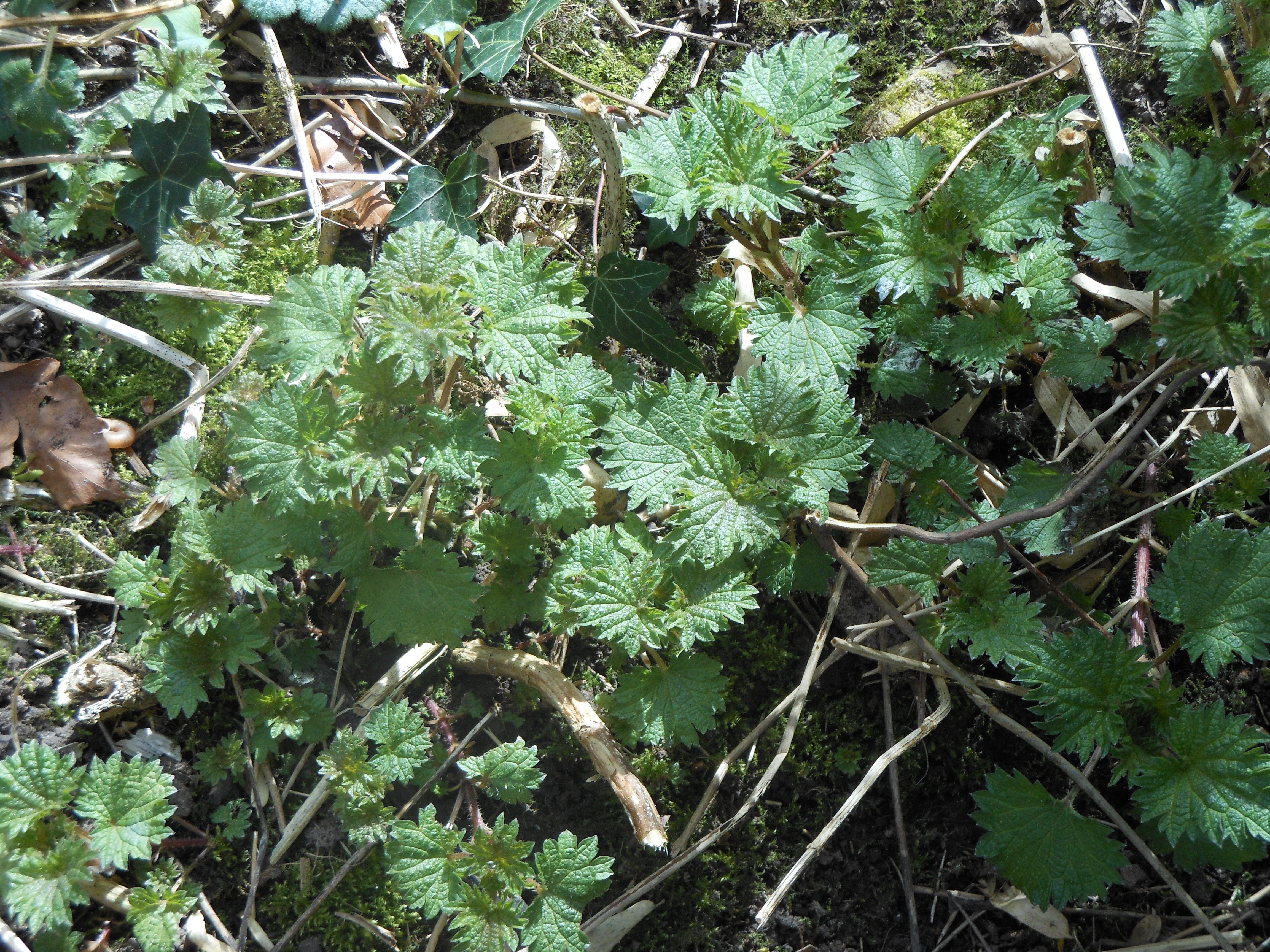 |
APRIL 2013
NETTLE TEA
In April the garden comes to life again, and the need for weeding begins once more. All too soon the spiky leaves of the stinging nettles re-appear (see photo of them just poking up!) and it’s easy to want to chuck them on the compost heap without realising the beneficial health-giving properties that they contain.
The common stinging nettle Urtica Dioca has been used by herbalists for centuries who valued the leaves for their capacity to dispel stubborn mucus that lingered from their patients’ winter coughs. The young leaves are respected by modern herbalists and are used in an infusion as an iron tonic to treat anaemia, as a gargle for sore throats, as a diuretic to help remove urinary gravel and water retention, to treat high blood pressure and cystitis and as a lotion for nervous eczema. A tea made from the leaves is also useful as a spring blood purifier and tonic after a diet of too many rich comfort foods eaten during the winter. Unlikely as it sounds arthritic stiffness can be soothed by rubbing fresh nettles into the skin over the affected area.
Analysis of the fresh nettle shows the presence of formic acid, mucilage, mineral salts, ammonia, carbonic acid and water. It’s the formic acid in the nettle with the phosphates and iron they contain which make it such a valuable food medicinally. Properties: Iron tonic, mild diuretic, antihistamine, strengthening and styptic.
To make nettle tea, use the fresh leaves in the following proportions: 1 oz (25g) leaves to 1 pint (500ml) water. Put the fresh leaves into a teapot. Pour over the boiling water and leave to infuse for 15 minutes. Standard adult dose is 1 cup up to three times a day.
The leaves should be gathered in the morning after the sun has dried off the dew. Take care to wear gloves when picking them as you can so easily be stung. If you are, you can try rubbing the afflicted area with a dock leaf (Rumex crispus). Docks always seem to grow near nettles, and the old rhyme went:
Nettle in, dock out,
Dock rub nettle out! |
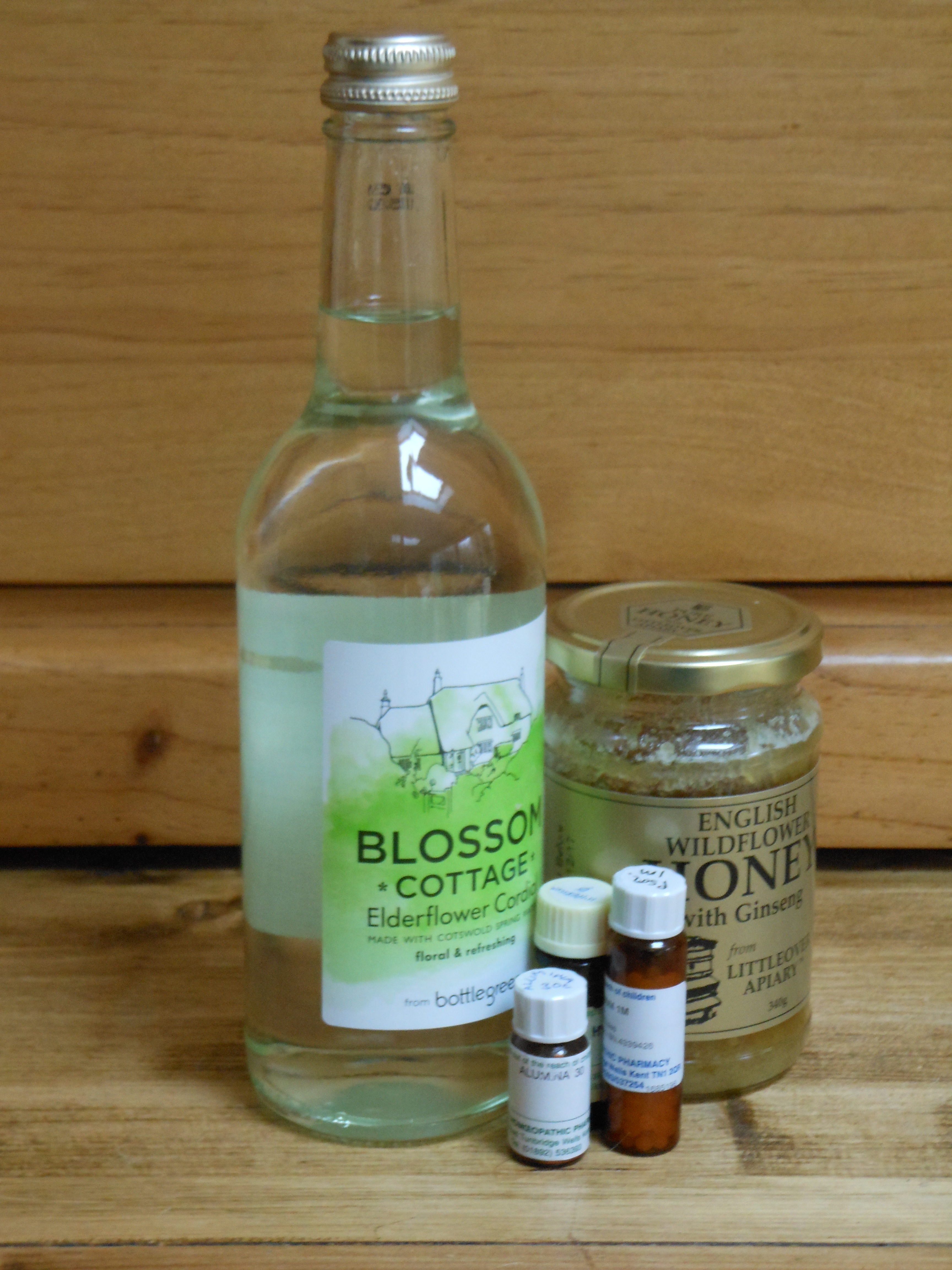
|
MARCH 2013
HAY-FEVER PREVENTATIVE MEASURES
Now’s the time to start taking preventative measures to avoid the worst of the symptoms triggered by the forthcoming hay fever season. Some people develop symptoms early in the year, while others don’t start sniffling until harvest time, so begin in the best time appropriate to your needs.
A simple remedy to begin with is eating a couple of spoons of local honey every day 2 months before the season starts. Local honey will contain local pollens that may trigger your hay fever, so by eating this honey you can help to desensitize yourself to local pollens. Only use cold pressed honey as honey loses its healing properties after being heated.
In addition, you can try drinking elderflower tea made from an infusion of elderflowers in the proportion of 1oz dried or 1 ½ oz fresh flowers to 1 pint (500 ml) of boiling water infused in a teapot and left to steep for a quarter of an hour. Strain it and take 3 cups of this tea every day for 2 months before your own particular hay fever sensitive time begins. You can buy dried elderflowers from herbalists such as Baldwins or you can buy elderflower cordial to try instead, but the home-made tea is more effective.
For a more profound constitutional remedy homeopaths recommend taking the homeopathic remedy Psorinum 30c, 1 tablet a week for 2 months until the hay fever season begins. If the hay fever season begins before you’ve had time to prepare with preventative treatment you can try the following remedies to treat the symptoms:
Allium Cepa 30c. Made from potentised onions, this homeopathic remedy is excellent for sneezing and runny noses. Take it in the dose recommended on the bottle. Euphrasia Tincture. Made from the herb Eyebright, this remedy is excellent for soothing itching eyes. Finally, the homeopathic remedy Mixed Pollens 30c is made from a variety of pollens which may be stimulating your symptoms. All these remedies can be obtained from the homeopathic pharmacy Helios on www.helios.co.uk |
 |
FEBRUARY 2013
Many people suffer from muscular stiffness and arthritic joint pain during the damp month of February, so this time I’m featuring various remedies you may like to try to alleviate these symptoms. Of course if your condition deteriorates do consult your doctor, but the following suggestions may help you feel better as they are complimentary rather than alternatives.
First of all, consider the help gentle exercise can bring. I find swimming a brilliant method of loosening up in winter as taking exercise in this way is so enjoyable because the water supports the body and takes the strain. I prefer to go early in the morning when the public pool near my home is quieter, but I always feel the benefit of increased suppleness and circulatory and respiratory well-being afterwards too. My husband prefers Tai Chi, and this is another great way of preventing and relieving the stiffness that can develop as we grow older.
Massage is also a wonderfully comforting and the use of essential oils can really help stiff muscles and smooth away tension. Lavender oil used with a good quality unscented cream is a wonderful anti-rheumatic rub. The following more complex recipe using 2 drops of coriander, 4 drops of juniper and 4 drops of black pepper essential oils added to 2 teaspoons of grape-seed oil is another good combination used as a muscle rub, but do not use this if you are pregnant. (This latter formula was obtained from Element’s Encyclopaedia of Healing Remedies which is an excellent source of information.)
Then there are supplements that have been proven to help stiff and painful joints, and I can personally recommend Green-Lipped Mussels. Capsules made from these sea creatures which grow in the unpolluted waters around New Zealand have been proven over 30 years of trials to really help. Anecdotal reports of the Maoris rarely developing osteoarthritis because they have traditionally had a diet rich in green mussels first encouraged me to try this supplement. They contain nine major sources of glycosamineoglycans and are a good source of amino acids. Anti-inflammatory, they help to strengthen the immune system, repair damaged cells and maintain general energy.
Finally, I can recommend the homeopathic remedy Rhus Tox (rhus toxicodendron) for acute stiffness that’s worse after sitting or lying down, better on movement, then worse on movement again, making the sufferer restless especially at night. This remedy can be used in the 30c potency up to 3 doses of 1 tablet in a day over 2 days, but if the symptoms persist, do see a professional homeopath for constitutional treatment.
These remedies can be obtained from most good Health Food shops and Instructions on the packets and bottles must always be followed carefully. |
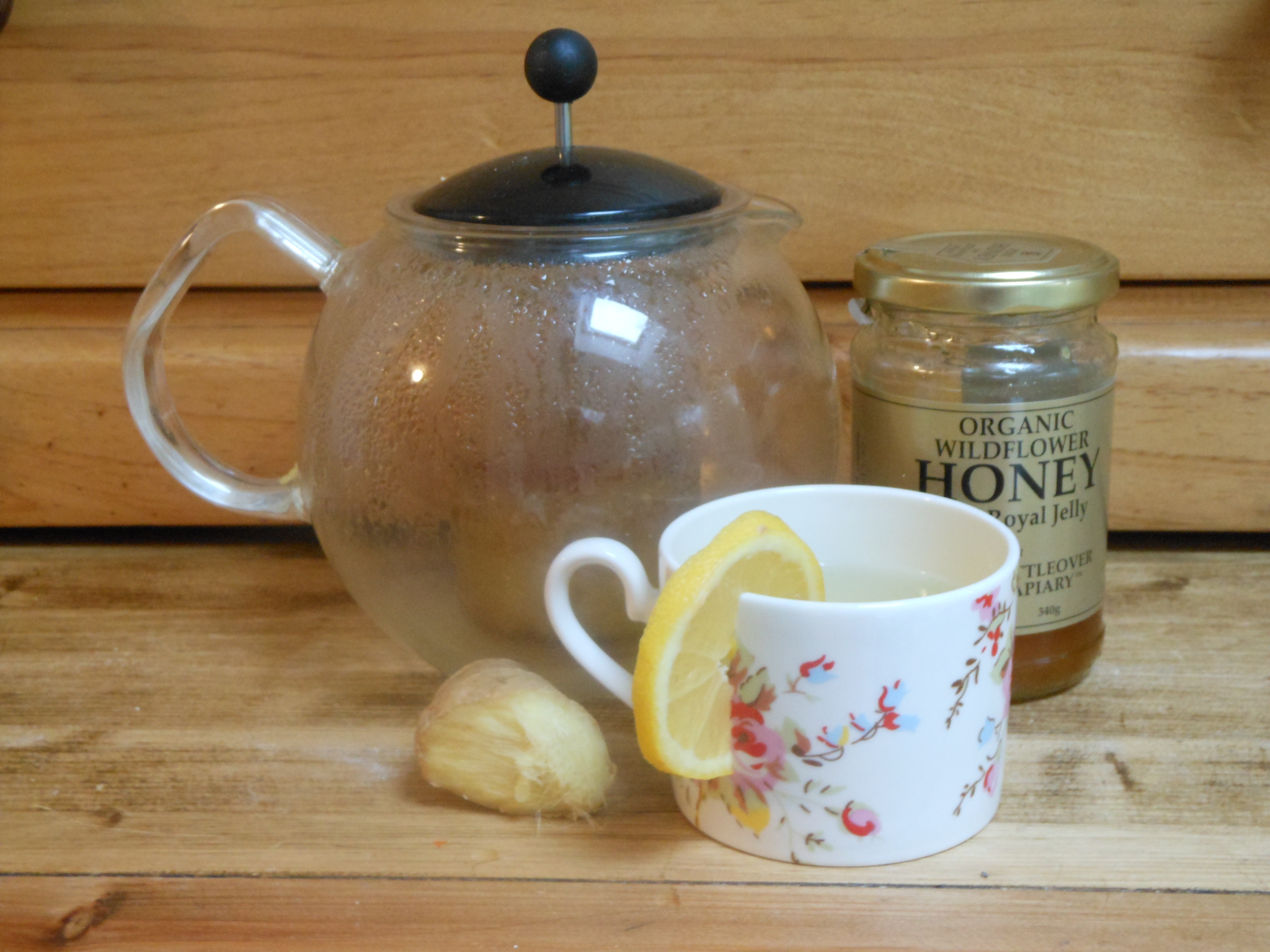 |
JANUARY 2013
GINGER TEA
January can be a month of colds and flu, when people’s immune systems come under strain as winter begins to bite. My favourite remedy for colds is ginger tea. Used in Chinese medicine for centuries, ginger tea is also good for indigestion, vomiting, belching, abdominal pain, motion sickness, laryngitis, arthritic pain and headaches. Some people find it helpful with memory loss. Ginger is a warming stimulant; it is diaphoretic, antidepressant, expectorant and can bring on delayed menstruation. For this reason it is best avoided by pregnant women with a history of miscarriage.
Ginger tea is made from the rhizome of zingiber officianale which is available from most good greengrocers.
Make a teapot of ginger tea using the following proportions: 2 teaspoons of grated fresh ginger root to ½ pint (10 fluid oz) of boiling water. Put these in a teapot large enough for the amount required and leave to steep for 5 minutes. Serve with half a teaspoon of honey and a slice of lemon. |
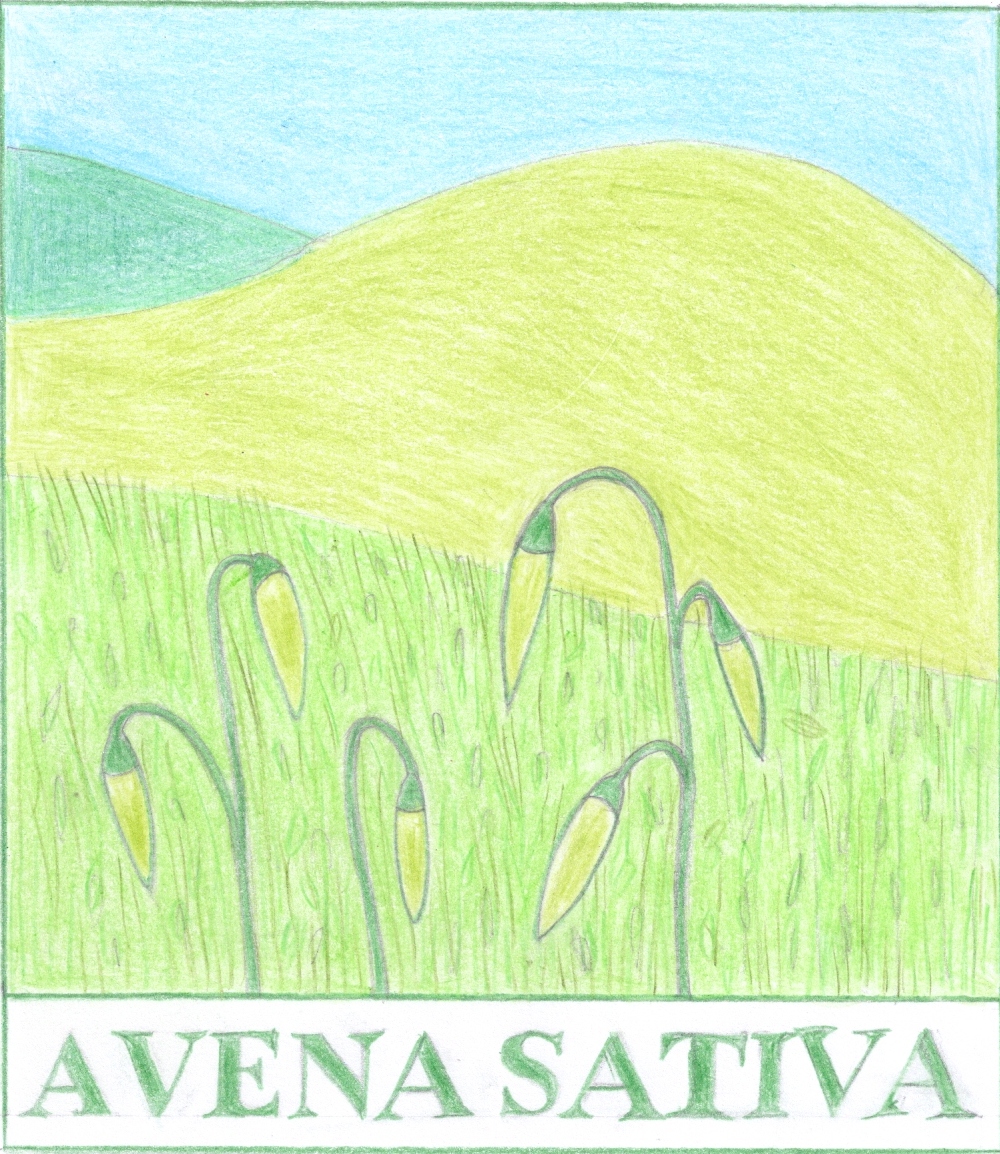 |
DECEMBER 2012
All that hectic activity that preparation for the festive season creates can get too much sometimes. This is why I’m suggesting you might like to try taking Avena Sativa, a wonderful nerve tonic. Avena Sativa is the botanical name for common oats, the kind that you have in porridge or make flapjacks with.
Commonly use to help addicts come off their drugs to relieve ‘cold turkey’ symptoms this remedy is invaluable for people suffering from nervous exhaustion, people with weak immune systems and for people who’ve been diagnosed with Chronic Fatigue Syndrome. It is also very restorative if you get a cold or flu and can help with insomnia. Elderly people or those suffering from diseases such as Parkinsons may find it helps to calm tremors due to its beneficial effect on the nervous system.
The recommended dose is 10 to 20 drops of Avena Sativa tincture in a cup of warm water once daily, but in cases of flu you can take 20 drops of the tincture in a cup of warm water hourly for a few doses. Avena Sativa tincture is available from Helios Pharmacy at www.helios.co.uk (Phone 01892 537 254). |
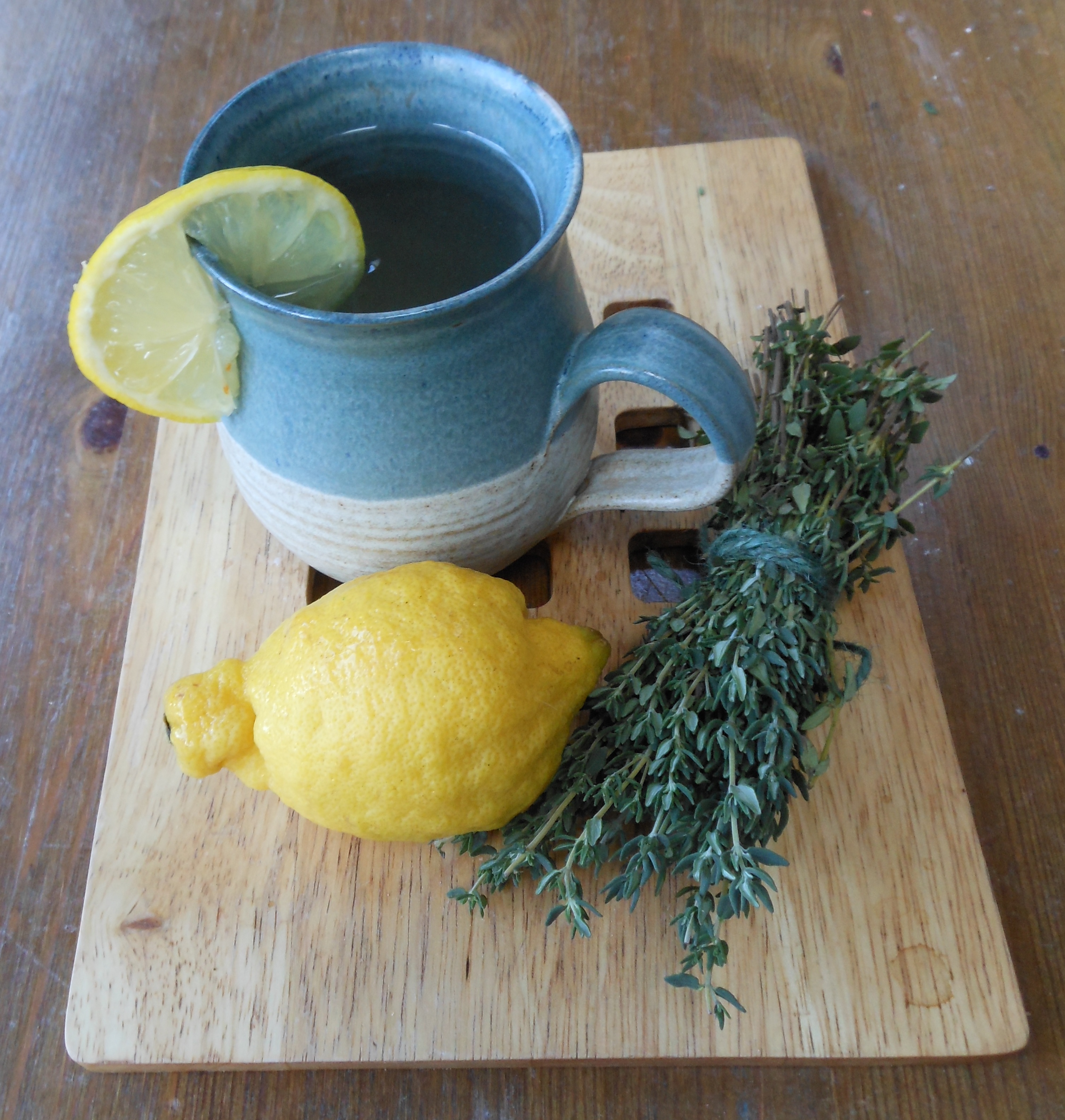 |
NOVEMBER 2012
THYME TEA FOR COUGHS
November’s fogs and chills can bring on coughs, especially for those who may have been standing for hours in the cold round a smoky bonfire with excited children. Traditionally known as a ‘source of courage’, thyme tea is a wonderful remedy for coughs. It was recommended by Nicholas Culpeper, the 17th Century herbalist who said it was ‘good for chin-cough in children as it strengthens the lungs’.
The proportions below are recommended for infusions by modern herbalists. I use thyme (thymus vulgaris) grown in my garden, dried or frozen in individual ice cubes while it was at its best. 1oz (28g) of thyme to 1 pint (568ml) of boiling water made in a teapot and allowed to infuse for 10 minutes. The dose is 2 fluid oz (56ml) three or four times a day with a little local honey dissolved in it to taste as honey has antiseptic properties. It’s amazing how soothing and warming it is to a sore chest. This infusion also improves the appetite and relieves dyspepsia and gastritis as thyme is a natural antiseptic and is rich in thymol which helps all bronchial symptoms. |
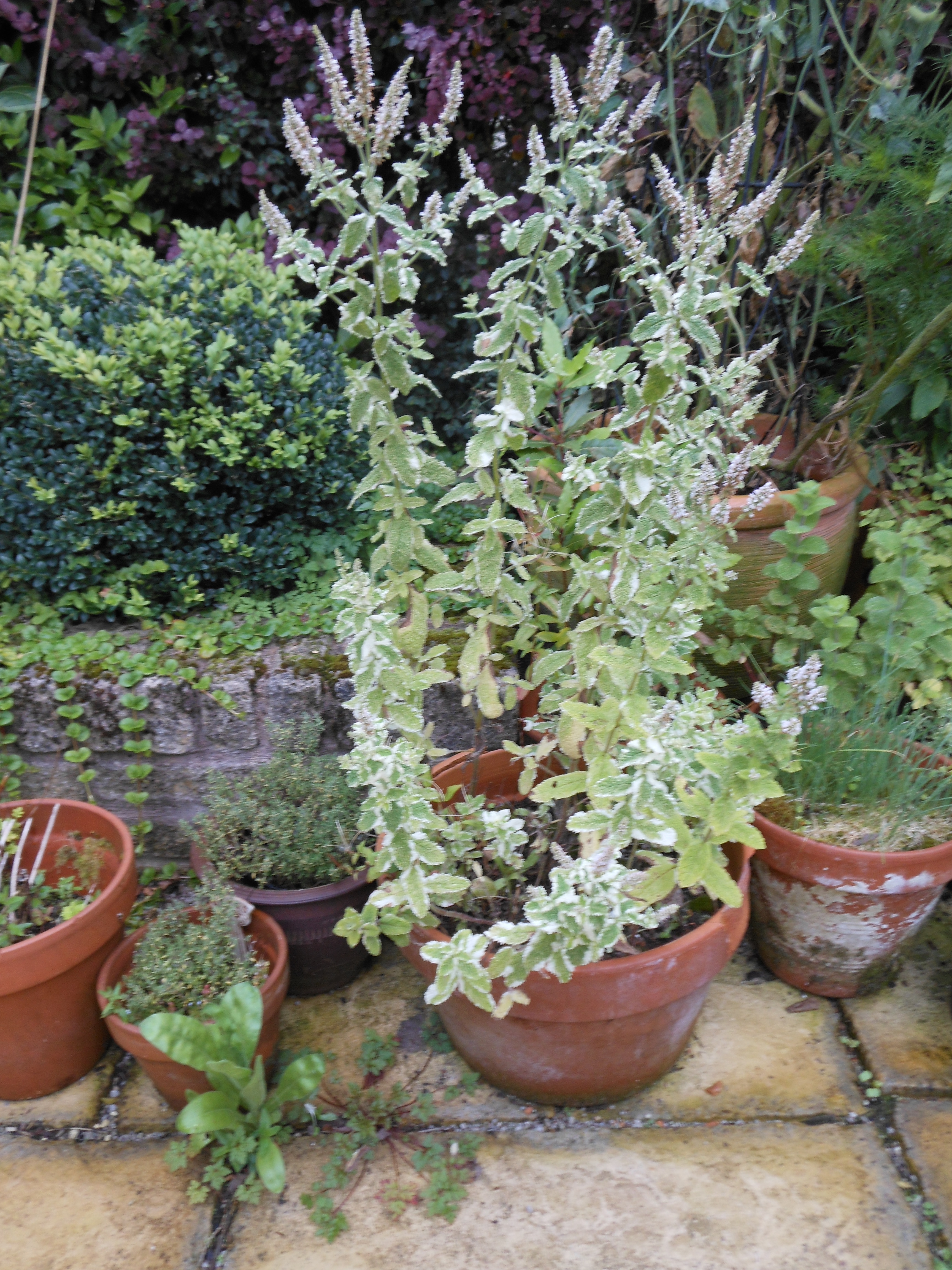 |
OCTOBER 2012
This time of the year it’s time to clear up the herb garden to harvest any herbs before the frosts kill them. This year I’ve had a bumper crop of Sage, a wonderful herb useful both for cooking and for medicinal purposes. Because the soil in my garden is such heavy clay I have to grow herbs like sage that require free-draining soil in pots. The variety in the picture is Painted Sage (salvia viridis) a beautiful annual with variegated leaves.
It’s also the time when the weather can suddenly change and sore throats appear. To treat these I make up infusions of Sage Tea: spoon 1 ½ teaspoons of fresh leaves (1teaspoon dried) per cup into a teapot, pour hot water over them then leave to cool for a gargle, or drink warm with honey for a throat-soothing drink. You can take 1 cup 3 times a day for a standard dose, or every 2 hours in acute conditions to a limit of 6 cups per day. Reduce the dosage for children e.g. give a child of 7 half the adult dose. Traditionally, 1 cup a day maintains health in old age. Do not give to children younger than this.
Sage has the following properties: astringent, stimulant, antiseptic, carminative, anti-spasmodic, nervine, general strengthening and helpful for women with period pains and during the menopause.
Caution: avoid if allergic to salicylates (aspirin). |
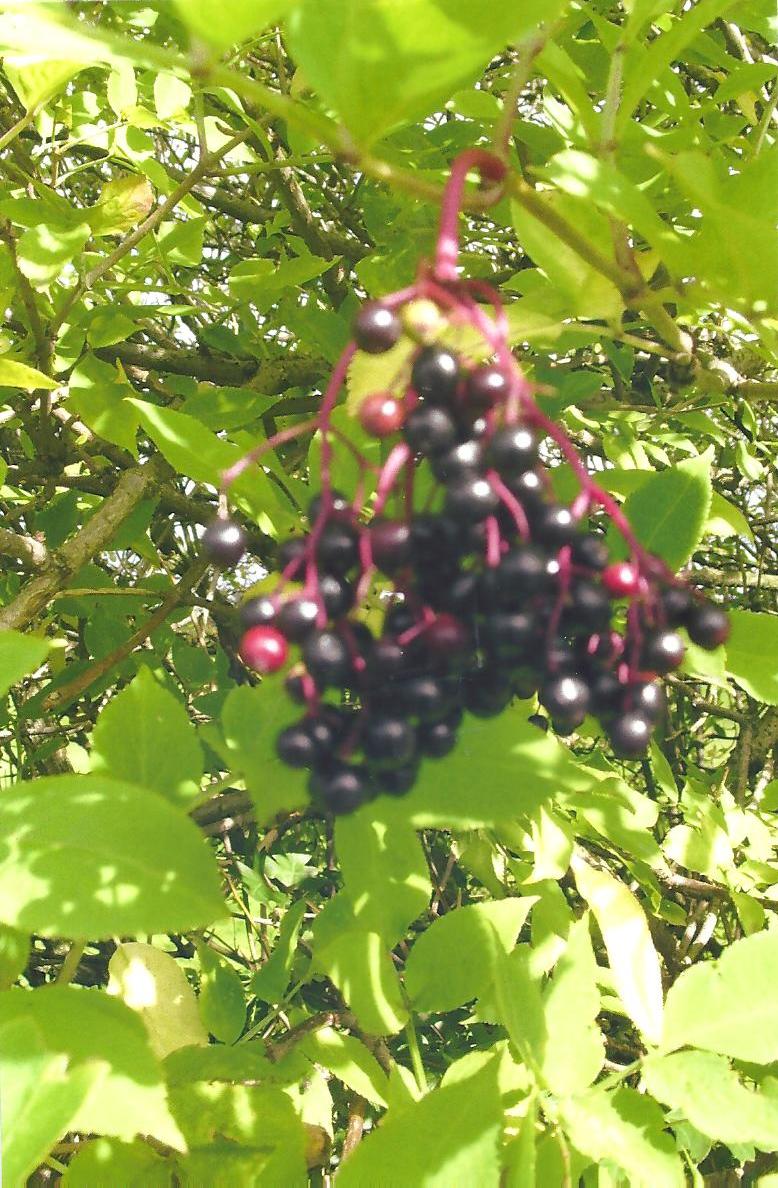 |
SEPTEMBER 2012
HEDGEROW HARVEST
As a therapist I’m often asked for help by people with weakened immune systems. The following inexpensive remedy is a wonderful immune system booster, using ripe elderberries that can be gathered for nothing from any pollution-free hedgerow in September. Elderberries (sambucus nigra) have powerful antiviral properties, so are excellent for prevention against and treatment of various different influenza strains. Tests conducted in Norway and Israel using elderberries showed flu symptoms reduced to two days rather than the usual five. Vitamin C -rich elderberries are anti-inflammatory and antioxidant, being diuretic, laxative and emetic. Homeopaths use elderberry-based remedies for patients with respiratory problems with tenacious mucus and loose coughs who are constantly fretful and frightened of suffocating.
Mulled Elderberry Cordial
2 kilos (5lbs) elderberries gathered on a sunny day, and enough water to cover them in a large pan
10 cloves in a muslin bag
450g (1lb) Demerara sugar
2cm (3/4”) fresh ginger
1 teaspoon powdered cinnamon
1 orange
Wash the elderberries and strip from their stalks with a fork. Place in the pan, cover with water, bring to the boil and simmer until soft. Strain through a sieve to remove the seeds then return to the pan. For every 600ml (1 pint) of liquid add 450g sugar, the finely grated zest and juice of 1 orange, 10 cloves, ginger and cinnamon. Simmer until sugar has dissolved, stirring all the time with wooden spoon, then boil fast for another 10 minutes. When the liquid is cool remove ginger and cloves. Store in the freezer in ice cube trays, then when frozen store in plastic freezer bags. When needed, thaw out two ice cubes and add enough hot water to make a hot toddy; serve with a slice of fresh lemon. It smells like Christmas and tastes wonderful. Sip as needed. |
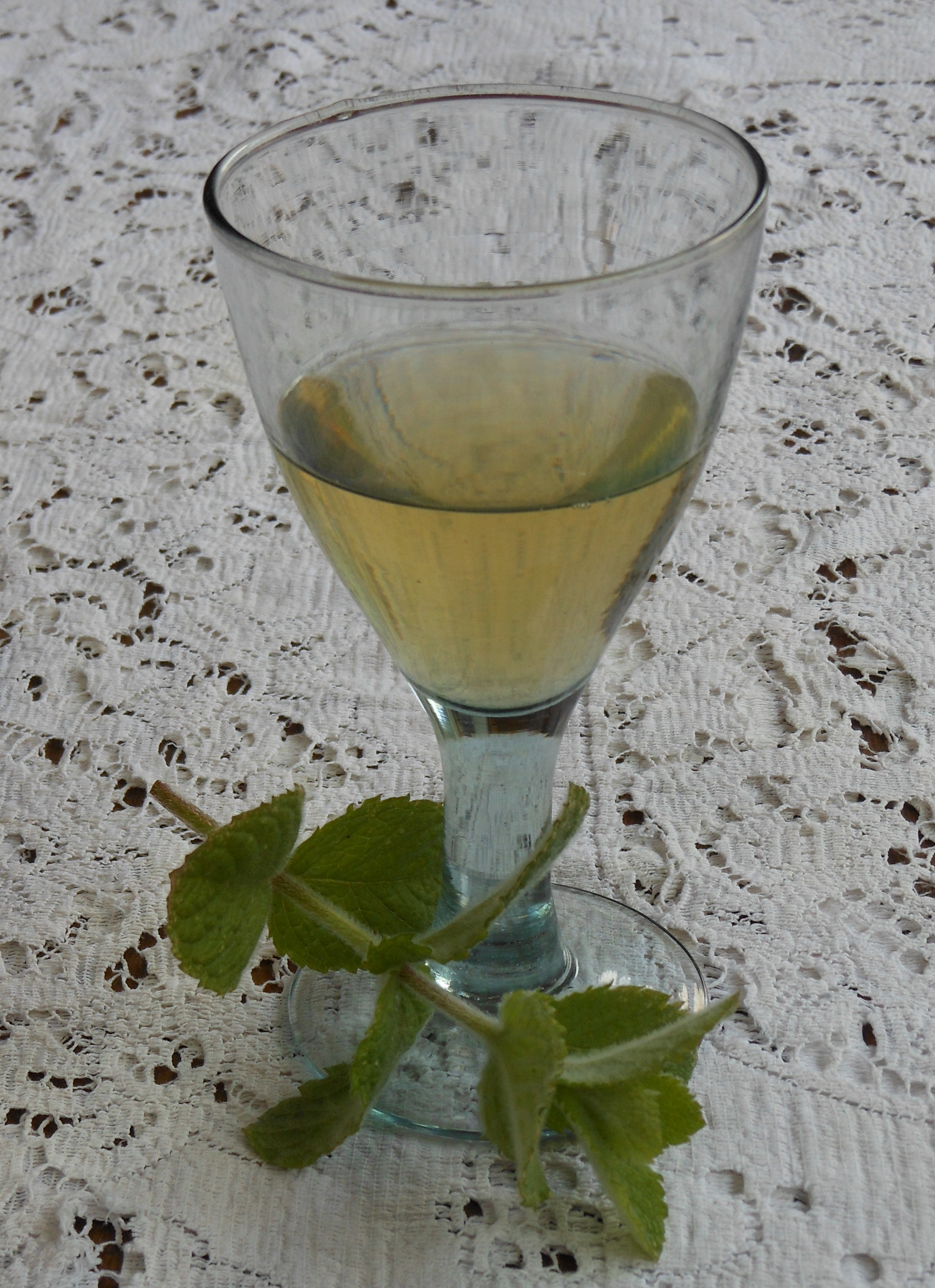 |
AUGUST 2012
Applemint Cooler
This simple-to-make soothing apple-mint drink settles digestive upsets that can occur in hot weather. Serve in a cool glass and sip as often as needed.
½ oz (125g) fresh apple-mint leaves
1 pint of water
1 teaspoon of local honey
1 tablespoon of apple juice
Method
In a teapot infuse the apple-mint leaves in 1 pint of boiling water for 15 minutes then add the tablespoon of honey. Stir and sieve into a Pyrex jug then leave to cool in the fridge.
When cool, add 1 tablespoon of apple juice to the jug. Serve in a glass with a few apple-mint leaves scattered on top.
Properties of apple-mint leaves are: digestive, carminative, antispasmodic, and apple juice neutralizes indigestion and detoxifies; honey is antiseptic. This drink can help indigestion, nausea, colic, wind, vomiting, lack of appetite and menstrual cramps.
Remember that if your digestive symptoms appear after you have taken a homeopathic remedy for another condition, mint can sometimes antidote the healing process of the homeopathic remedy. If this is the case, don’t make the apple-mint cooler but instead do consult your homeopath. Your symptoms may be part of your body’s response to the homeopathy and will be a good sign of healing. |
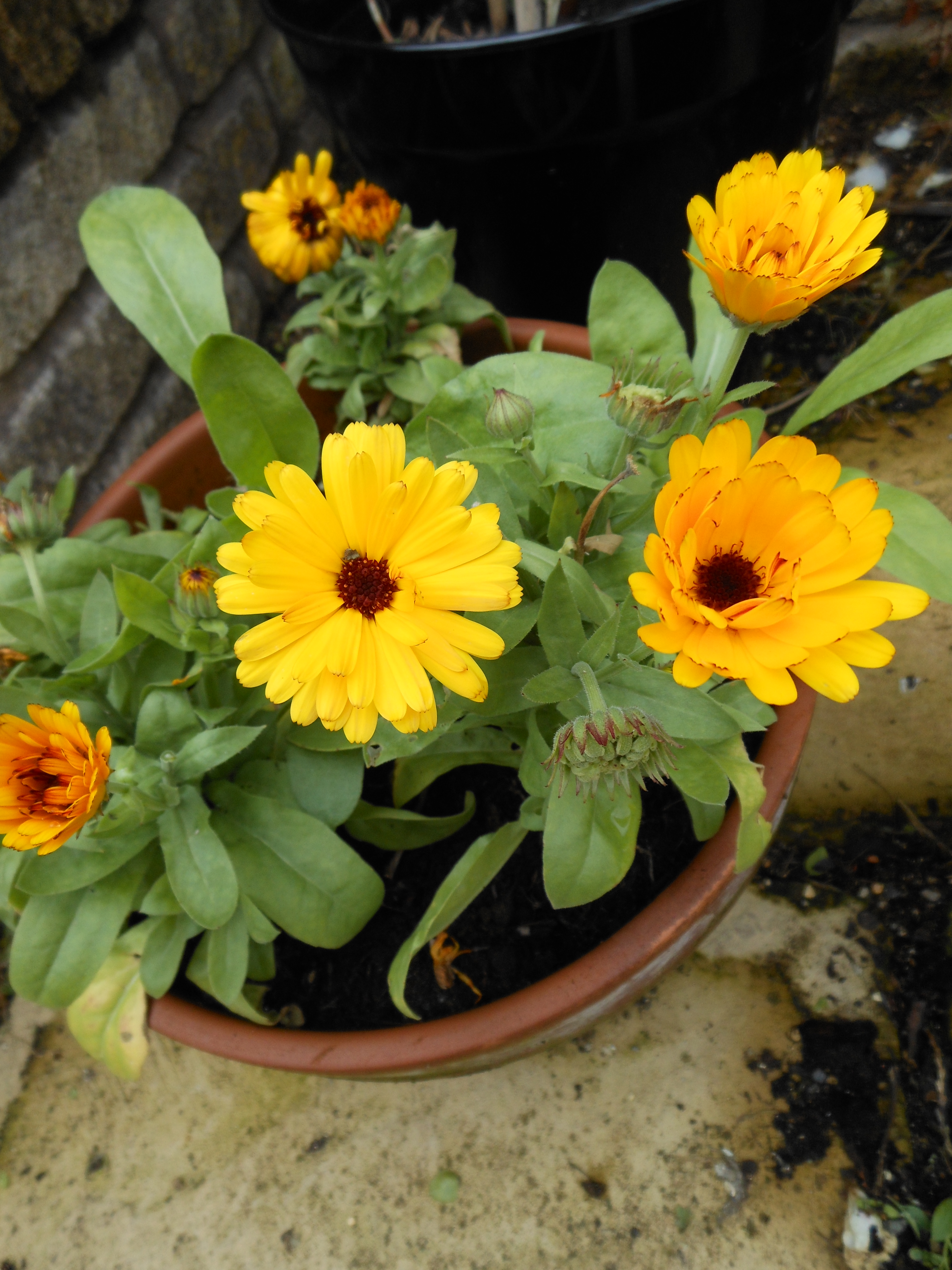 |
JULY 2012
Marigold Lotion
Cuts, grazes and irritating insect bites can often cause uncomfortable skin problems in hot July weather spent out of doors. One of the best remedies for bathing wounds of this type is a lotion made from the flowers of the old-fashioned marigold, Calendula officinalis. A soothing lotion can be made by adding 4 flower heads of marigold: 2oz (50g) to 2 cups (500ml; 16 fluid oz) of boiling water and allowing them to infuse for 10 minutes. I use a transparent tea-pot so I can see how the liquid is progressing. Allow to cool and strain through a sieve into a jug. Pour into a tightly-stoppered container and it will keep for 3 days in the fridge.
Wash to remove dirt from the affected part of the body and then bathe with the marigold lotion. This plant is antiseptic, antifungal, anti-spasmodic, healing and anti-inflammatory .
NB. Take care with insect bites if any sudden swelling of face and neck, red and blotchy skin and breathlessness should arise. Some people are allergic to bee stings for example and in rare cases can be subject to anaphylactic shock. Seek medical help if you are at all in doubt and in the meantime sit the patient in an upright position to help them to breathe more easily. |
|
| |
| |
|